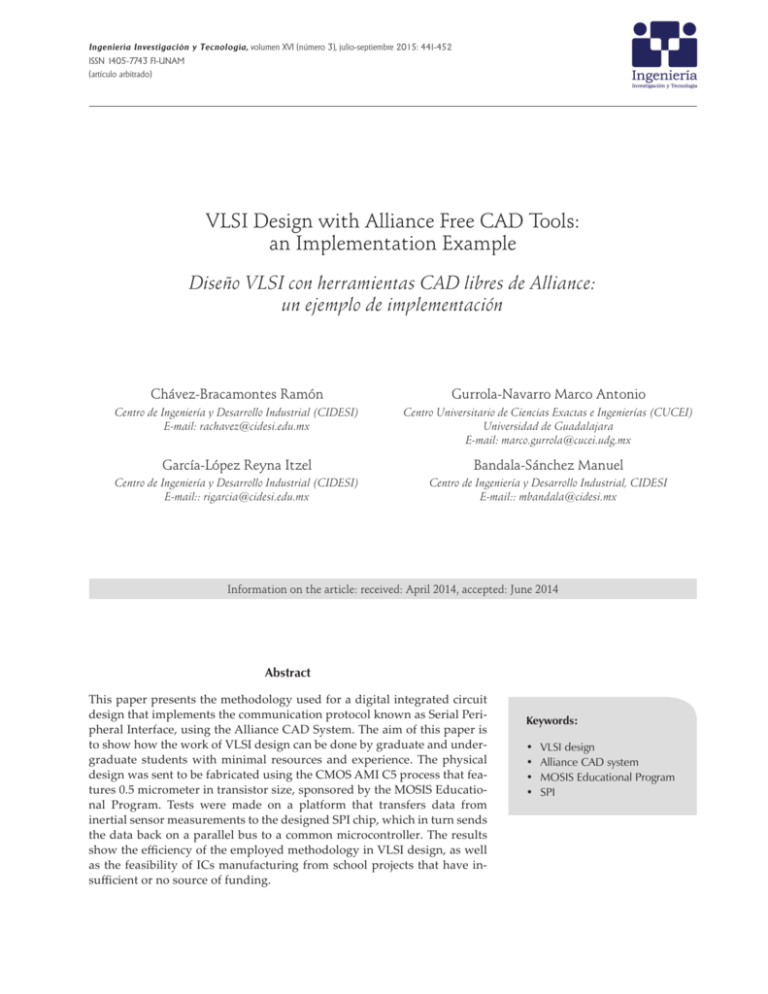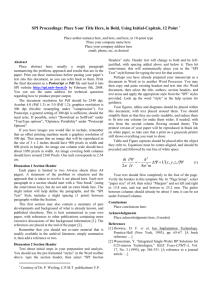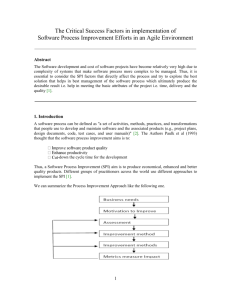
Ingeniería Investigación y Tecnología, volumen XVI (número 3), julio-septiembre 2015: 441-452
ISSN 1405-7743 FI-UNAM
(artículo arbitrado)
VLSI Design with Alliance Free CAD Tools:
an Implementation Example
Diseño VLSI con herramientas CAD libres de Alliance:
un ejemplo de implementación
Chávez-Bracamontes Ramón
Gurrola-Navarro Marco Antonio
Centro de Ingeniería y Desarrollo Industrial (CIDESI)
E-mail: rachavez@cidesi.edu.mx
Centro Universitario de Ciencias Exactas e Ingenierías (CUCEI)
Universidad de Guadalajara
E-mail: marco.gurrola@cucei.udg.mx
García-López Reyna Itzel
Bandala-Sánchez Manuel
Centro de Ingeniería y Desarrollo Industrial (CIDESI)
E-mail:: rigarcia@cidesi.edu.mx
Centro de Ingeniería y Desarrollo Industrial, CIDESI
E-mail:: mbandala@cidesi.mx
Information on the article: received: April 2014, accepted: June 2014
Abstract
This paper presents the methodology used for a digital integrated circuit
design that implements the communication protocol known as Serial Peripheral Interface, using the Alliance CAD System. The aim of this paper is
to show how the work of VLSI design can be done by graduate and undergraduate students with minimal resources and experience. The physical
design was sent to be fabricated using the CMOS AMI C5 process that features 0.5 micrometer in transistor size, sponsored by the MOSIS Educational Program. Tests were made on a platform that transfers data from
inertial sensor measurements to the designed SPI chip, which in turn sends
the data back on a parallel bus to a common microcontroller. The results
show the efficiency of the employed methodology in VLSI design, as well
as the feasibility of ICs manufacturing from school projects that have insufficient or no source of funding.
Keywords:
•
•
•
•
VLSI design
Alliance CAD system
MOSIS Educational Program
SPI
VLSI Design with Alliance Free CAD Tools: an Implementation Example
Resumen
En este artículo se presenta la metodología usada en el diseño de un circuito
integrado digital que implementa el protocolo de comunicación denominado
Interface de Periféricos Serial, utilizando el sistema CAD Alliance. La finalidad es mostrar cómo la tarea del diseño VLSI puede ser realizada por estudiantes o profesionistas, con un mínimo de recursos y experiencia. El diseño
físico fue enviado para su fabricación usando el proceso CMOS AMI C5 caracterizado por un tamaño de transistor de 0.5 micrometros, auspiciado por el
programa educativo de MOSIS. Las pruebas se realizaron sobre una plataforma que transfiere los datos desde mediciones de un sensor inercial hacia el chip
SPI diseñado, el cual a su vez envía los datos de nuevo por un bus paralelo
hacia un microcontrolador común. Los resultados mostraron la eficacia de la
metodología de diseño VLSI empleada, así como la factibilidad de fabricación
de diseños realizados en proyectos escolares cuyas fuentes de financiamiento
sean insuficientes o nulas.
Introduction
Nowadays, there are sophisticated commercial computer aided design (CAD) tools for professional use in the
design of integrated circuits (IC) with very large scale
integration (VLSI) (Weste et al., 2011). Examples are Cadence Design System, Synopsys and Mentor Graphics
among others that require the payment of annual licenses. In public education institutions, the cost of software licenses becomes a limiting factor as well as the
fact that their use is complex by novice designers.
The design process begins with the specification of a
digital system and its description through a hardware
description language such as VHDL (very high speed
integrated circuit hardware). Once the behavioral description of a digital system design has been coded in
VHDL, the software tools that allow synthesis and verification to obtain the physical plane of the IC are deployed (this process is known as flow design). Subsequently,
the physical planes are generated in digital files that are
sent for fabrication.
Students, professors and researchers that carry out
VLSI design can use the software tools that allow the
design flow of VLSI ICs in their studies and research
projects because the learning curve is short. Alliance
CAD System is the name of a complete set of CAD tools
and VLSI design libraries that were developed in the
Pierre et Marie Curie laboratory in Paris, France. Alliance
is an environment friendly CAD system licensed under
GPN Linux (LIP6, 2014; Silva et al., 2006). This software
allows the design and test of VLSI circuits, from the
specification to the physical layout, providing libraries
of cells that allow the design of independent circuits
specific to the technology used in the manufacturing
process.
442
Descriptores:
• diseño VLSI
• sistema CAD Alliance
• programa educativo MOSIS
•SPI
In this paper, the design methodology uses the
Alliance CAD System tools for the design of a VLSI IC
and is exemplified by the implementation of a communication protocol. Figure 1 shows a diagram of the
method implemented in the design flow (Ortega, 2009;
Reyes, 2011). The manufacturing stage and packaging
was made through the MOSIS Educational Program
(MEP) (Piña, 2002). The MOSIS Service (or MOSIS) provides manufacturing services at no cost to educational
institutions with minimum financial support for nonprofitable applications (Staudhammer, 1997; The MOSIS Service, 2014).
This paper is organized as follows: first, the specification of what the chip must do is presented. Second,
an architecture design of the entire system in a hierarchical way is proposed. Third, the logic design is developed in a hardware description language. After that,
the synthesis flow of the Alliance CAD tools is used.
Then a test bench was prepared for verification design,
followed by the place and route stage that was validated with the Alliance CAD tools before generating layouts files in a standar CIF format. Once the design was
completed, it was sent for fabrication and packaging
using the MOSIS Educational Program. Experimental
testing was made for the chip using specialized citcuitry. Finally conclusions on this work are provided.
Specifications
The SPI protocol is a four-wire serial peripheral device
that features a synchronous and bidirectional (full duplex), communication standard developed by Freescale
(Leens, 2009). It is used to communicate microcontrollers with a variety of peripherals (A/D, EEPROMS, sensors, among others). SPI is a standard used to control
Ingeniería Investigación y Tecnología, volumen XVI (número 3), julio-septiembre 2015: 441-452 ISSN 1405-7743 FI-UNAM
Chávez-Bracamontes Ramón, García-López Reyna Itzel, Gurrola-Navarro Marco Antonio, Bandala-Sánchez Manuel
almost any digital electronic device that accepts a serial
bit stream controlled by a clock. It uses the following
signals: Data In, Data Out, Clock and Chip Select (CS)
or Enable. Some microcontrollers might use terms such
as Master-Out-Slave-In (MOSI) or data from master to
slave and Master-In-Slave-Out (MISO) or data from slave to master and Slave Select (SS) or slave selector.
This paper implements a SPI module with the main
functionality of the SPI communication protocol. The
module operates in master mode, and allows the user
to configure the chip select signal (CS), clock polarity
control (CPOL) and the data transfer frequency (SCLK)
with up to 16 selection modes. The SPI module transmits/receives data frames of 16 bits, with the most significant bit of each word transferred first. The module is
flexible enough to communicate with standard peripherals from various manufacturers that incorporate
the SPI protocol.
Features:
• Master mode
• Chip select: active high or active low selection
• Full-duplex communication
• SCLK clock polarity selection: active high or active
low
• Clock phase (CPHA): mode 1 is default
• 16 frequency setting modes: divider between 2, 4, 8,
16, ..., 65536
• Data frames of 16 bits
• One peripheral in slave mode
Architecture design
The design of the architecture of a VLSI digital integrated circuit begins with the development of the idea of
Figure 1. Flow methodology for designing a VLSI IC
the main module that will be called core. Followed by
the definition of the module in terms of inputs, outputs,
and a description of the specific function. Figure 2
shows a general diagram of the SPI MASTER. Table 1
describes the I/O terminals. In Figure 3, the modules
SPI META, SPI CONFIG, SPI CONTROLLER, SPI
CLOCK DIVIDER and SPI DATA BUFFER define the
architecture of the SPI MASTER core.
SPI META Module
The SPI Master core requires that the external signals be
stable and synchronous during internal communication, therefore this module is necessary to prevent metastability problems (Wakerly, 2006). The input signals
that require synchronization with the clock signal are
ESTART and EW, generating the START, W. On another
hand the signals ESCLK and ECS are passed trough DFlip-Flops inside the SPI_META Module before be sended to the Slave device as the SCLK and CS signals.
This is required in order to eliminate the transitory glitches that ESCLK and ECS could have, ensuring that the
logic levels of SCLK and CS is stable along all the complete clock period (Wakerly, 2006).
SPI CONTROLLER Module
The SPI CONTROLLER module is responsible for
producing the control signals (ECS ESCLK, BUSY and
SHIFT) in the correct sequence in order to run processes with the required timing. The module consists of
a main state machine that provides the inputs and
outputs to multiple threads and it is constituted of
two nested state machines that perform low-level
processes.
Figure 2. I/O terminals from the SPI
MASTER core
Ingeniería Investigación y Tecnología, volumen XVI (número 3), julio-septiembre 2015: 441-452 ISSN 1405-7743 FI-UNAM
443
VLSI Design with Alliance Free CAD Tools: an Implementation Example
Table 1. Terminal description
Terminal
Type
Description
CLK
Input
Clock oscillator with a maximum frequency of 25 MHz
RST
Input
Performs a reset on the system
DATA_IN
Input
Input data bus (8 bits)
DATA_OUT
Output
Output data bus (8 bits)
EW
Input
Enables writing of internal registers
BYTE_HL
Input
Select the upper or lower byte from the 16-bit registers
ESTART
Input
Start the transmission/reception between the SPI Master and Slave
CONFIG
Input
Enables the configuration parameters required for the Master module
BUSY
Output
Reports that the module is busy
CS
Output
Enables communication between the SPI Master and Slave module
SCLK
Output
Clock between SPI Master and Slave module
MOSI
Output
Output serial data bus of the SPI Master
MISO
Input
Input serial data bus to the SPI Master
SPI CONFIG Module
The SPI Master core requires a number of configuration
parameters to perform its functions. These parameters
are stored in a register within the configuration module
namely:
• Setting the frequency of the SCLK output signal
• Setting the active level of the chip select signal (CS)
• Setting the polarity (CPOL) for the SPI bus clock
(SCLK)
SPI CLOCK DIVIDER Module
The SPI CLOCK DIVIDER module is designed to provide up to 16 clock modes as desired. The frequency division factor is defined by the SELECTOR bus signal.
SPI DATA BUFFER Module
This module contains the 16-bit register called REGISTER_DATA. It is intended to store the data to be transferred by the MOSI signal, as well as to receive the data
from the MISO signal during the transmit/receive operation. This way, the data can be read from the output
data bus (DATA_OUT) when the core finishes the
transfer between the SPI Master and Slave module.
Principle of operation
The SPI Master core operation begins by enabling the
RST signal and allowing the system to start with specific initial conditions. Subsequently, the core performs a
one-time setup process and, followed by a cyclical writing, transmission-reception and reading.
444
The configuration process starts with the definition
of parameters such as CS=0, CPOL=1 and SELECTOR=0x0.
In this example the setting data will be equal to 0x20. To
perform this configuration, the data are set in DATA_IN
bus, after that, the CONFIG signal is set high, and finally
the EW signal is set high, only under this condition, the
chip is already configured and it is ready for the cyclical
of writing-transmit-receive-reading process.
The writing process starts when the CONFIG signal
is disabled, thus the first byte enters in DATA_IN to be
written in REGISTER_DATA depending on BYTE_HL
signal and if EW signal is enabled. For example, maybe
we need the address 0x0007 be the data stored in REGISTER_DATA which will be sent by the MOSI line.
Once the data is in the register, the transmission-reception process can begin. This process starts when the ESTART pulse is enabled, after that, SCLK, CS and BUSY
signals are enabled, in addition to sending the data by
MOSI and, simultaneously, receiving data from the
MISO line.
The reading process is initiated when the BUSY signal is disabled, thus the controller can perform the reading of data stored in REGISTER_DATA through the
DATA_OUT bus. Reading is performed by setting
BYTE_HL signal high or low, depending on the required byte to be read.
Logic design
Having defined the architecture, the next step is the logical description through a hardware description language (HDL), which describes the operation of a digital
logic circuit. VHDL and Verilog are the standard languages for logical description of an integrated circuit.
The logical design describes the interconnection topo-
Ingeniería Investigación y Tecnología, volumen XVI (número 3), julio-septiembre 2015: 441-452 ISSN 1405-7743 FI-UNAM
Chávez-Bracamontes Ramón, García-López Reyna Itzel, Gurrola-Navarro Marco Antonio, Bandala-Sánchez Manuel
Figure 3. The SPI protocol architecture is divided into 5 modules.
logy between gates and data transfer between registers.
The result of the logical design is a text file in HDL
code. This file contains a structural description of a module that is required to carry out the synthesis flow
from a logic level to a physical level. The following logical description in VHDL shows the metastability module. For simplicity, only the signal EW is described.
The code has two main sections: entity and architecture.
The types of the I/O signals are described in the entity
section. The architecture section describes the module
by its behavioral way. For more information about
VHDL refer to Mealy et al. (2013).
Synthesis flow The synthesis flow of Alliance CAD System (Lam,
2004abc) begins by using sources of behavioural
VHDL files to get structural VHDL files deploying automated synthesis tools; in this case tools such as vasy,
boom, boog and loon are used for optimization in
synthesis and verification. During this phase, the verification stage is assisted by simulators that allow checking for errors. The SPI Master core is developed
under a hierarchical or modular structure, such that
each module needs to be independently verified and
synthesized as outlined below (Reyes, 2011). Once
both the structural and behavioral files for each module are available, the next step is the integration into a
single structural file. In this case the genlib tool provi-
-- Metaestability module - META.VHDL
library IEEE;
use ieee.std_logic_1164.all;
use ieee.std_logic_unsigned.all;
entity META is
port(CLK: in std_logic;
EW:in std_logic;
W:
out std_logic);
end META;
architecture ARQ_META of META is
signal REG_W: std_logic;
begin
process (CLK,EW)
begin
if (CLK’event and CLK=’1’) then
REG_W<=EW;
end if;
end process;
W
<= REG_W;
end ARQ_META;
ded by the Alliance developers (Chaput, 2002) is used.
In this step a vector file with test patterns should be
prepared to perform the simulation and verification
used for the behavioral validation of the complete
core. The next step in the flow is known as place and
route, here the synthesis software transforms the logical design to a physical design. In the place phase,
standard cell libraries components are placed on tran-
Ingeniería Investigación y Tecnología, volumen XVI (número 3), julio-septiembre 2015: 441-452 ISSN 1405-7743 FI-UNAM
445
VLSI Design with Alliance Free CAD Tools: an Implementation Example
sistor level, and therefore, in the route phase electrical
connections are made between them. During this process, there are other phases for optimization of delays
and a consumption of area. The result of the synthesis is
a structural file named netlist, containing the list of cells
and macros, gates and interconnections between them.
Behavioral and structural synthesis of the modules
For synthesis of the SPI Master core, two processes are
necessary since this design is performed in a hierarchical manner. Each module is an independent design in a
hierarchical level. The first process is to synthesize each
module individually in order to obtain the behavioral
files (vbe files) and structural (vst files) used for the
structural synthesis of the entire core. The design flow
used for the synthesis of each module is shown in figure 4a (Ortega, 2009), where the following structural files
were obteined: meta.vst, clkd.vst, spiconfig.vst, sme.vst,
sdb.vst and meg.vst. Once the synthesis of each module
a)
has been performed, one must continue with the flow
of figure 5, using genlib, which is a circuit description
tool that includes a set of functions in the C programming language. To generate the structural core_spi.vst
file, firstly a text file with a .c extension must be edited.
This file will be the input file to the genlib tool. Finally,
figure 4b shows the structural synthesis flow, placement and routing the SPI core layout in order to obtain
the CIF file used for manufacturing.
Test Bench
In order to verify that the logic design complies with
the desired function, a number of test pattern files must
be prepared. The test files contain the expected response to an input stimuli sequence. This stage of the design
cycle is critical and requires careful definition of the test
patterns to ensure that the system responds correctly in
every state for any stimulus applied. I/Os representing
the SPI core functionality are defined in the stimuli file,
b)
Figure 4. a) individual module synthesis flow, b) final synthesis of the core
446
Ingeniería Investigación y Tecnología, volumen XVI (número 3), julio-septiembre 2015: 441-452 ISSN 1405-7743 FI-UNAM
Chávez-Bracamontes Ramón, García-López Reyna Itzel, Gurrola-Navarro Marco Antonio, Bandala-Sánchez Manuel
in our case core_spi.pat. The writing of the stimuli file is
a very time consuming activity. However the tool genpat undertakes this work in a procedural way. In (Lam,
2004a) tutorial part 1, more information on genpat can
be found.
Verification design
The stimuli files must contain the inputs and outputs of
the module to verify. This step is carried out with a tool
called asimut. In the synthesis flow, asimut is used at different stages, since it is necessary to verify each module
independently. Finally, a complete verification of the
core is necessary to identify errors before sending the design to fabrication. The behavioral validation stage is essential; it may represent more than 70% of the effort
devoted to the design of the chip. Simulation results of
the SPI Master core are shown in figure 6. It can be seen
that the proposed design perfomes appropriately.
Place & route
At this stage of the design process the layout plane
must be prepared (Figure 7). The ocp tool performs automatic placement of standard cells. The nero tool traces
the interconnections between transistors. A tutorial can
be found at (Lam, 2004). With the cougar tool, extraction
parameters of transistors and capacitances of the core
can be obtained. The lvx tool performs a structural
comparison of the extracted file against the original .vst
file to verify that the obtained core layout meets the initial specifications. This comparison is called Layout vs
Schematic. The obtained core contains a total of 3,477
transistors and its dimensions are 586 x 1451 lambdas
(symbolic units). Figure 7b shows the view of all the
layers of the design set by Alliance. Before sending the
design to fabrication it is necessary to perform a scaling
process into the chosen technology. In this step the s2r
tool is used.
Figure 5. Integration of structural files that synthesized the SPI Master core
Figure 6. Results of simulation of the SPI Master core
Ingeniería Investigación y Tecnología, volumen XVI (número 3), julio-septiembre 2015: 441-452 ISSN 1405-7743 FI-UNAM
447
VLSI Design with Alliance Free CAD Tools: an Implementation Example
a) b)
Figure 7. a) results for the place & route process, b) all layers
Padframe incorporation with the synthesis of the SPI Master core
In order to have external access to the obtained core layout we must incorporate input and output pads
around the core in a rectangular ring structure called
padframe (Figure 8). In this padframe, the manufacturer makes the connections between the leads and the
internal pins of the chip packaging. We can use the free
software tool called Magic to place the padframe (Magic, 2013). Magic can also be used for the design rule
cheking step (or DRC). With this step we check that the
layout does not have violations of the design rules, in
this way there is satisfactory confidence that the chip
will meet the specifications once it is manufactured.
Fabrication and packaging
The step prior to sending the chip for fabrication requires the scaling of the layout to the selected process technology and the design rules checking for physical
verification. There are two common ways to describe
layouts: 1) the Caltech Interchange Format (CIF) which
is used in universities, and 2) the Calma GDS II Stream
Format (GDS) which is normally used in the industry.
The final file of this work is a CIF file and it was sent to
the MOSIS Educational Program, see (Piña, 2002; Staudhammer, 1997).
Experimental results
The SPI Master core was designed with the Alliance
CAD System tools, by graduate students at the Centro
de Ingeniería y Desarrollo Industrial in Querétaro,
Mexico. Figure 9a shows a photo of the SPI Master core
chip. The chip was sent for manufacturing in January
2013 using the services of the MOSIS Educational Program (MEP). Three months later, five chips were received. The process used was C5 in ON Semi 0.5 micron
CMOS technology with a die size of 1.5 mm x 1.5 mm
wired in a DIP40 package. This process requires the use
of thin gold lines to connect the pads. The core die is
placed in the center of the package. The wiring process
was also carried out by MOSIS.
Once the chip was manufactured, tests and measurements were carried out. This ensured that all the design specifications were met and the chip worked
properly. To perform the experiments with the SPI
Master, a circuit that generated the control signals required by the chip was assembled. This circuit also set
the data settings and the addresses that would be read
from the slave device. Therefore the complete system
test was made on a platform comprised by the chip SPI
a) b)
Figure 8. Padframe
448
Figure 9. a) Microphotograph of the fabricated chip, b) DIP40
package
Ingeniería Investigación y Tecnología, volumen XVI (número 3), julio-septiembre 2015: 441-452 ISSN 1405-7743 FI-UNAM
Chávez-Bracamontes Ramón, García-López Reyna Itzel, Gurrola-Navarro Marco Antonio, Bandala-Sánchez Manuel
Figure 10. Complete System Test
a)
c)
Figure 11. Platform test
b)
d)
Figure 12. a) configuration, b) writing, c) transmission & reception, d) reading
Master, the controller device, and an SPI Slave device,
see Figure 10.
The tasks to be performed by the controller device
were:
a)Generate the control signals {RST, CONFIG, EW,
BYTE_HL, ESTART}, as required.
b)Set the setting data (6 bits) in DATA_IN master module.
c)Set the addresses (16 bits) as the SPI Master sends
through MOSI signal.
d)Receive the BUSY signal.
e)Receive the BUSY signal, the controller could read
data by the MISO signal. These data were read by the
DATA_OUT in blocks of 8 bits.
The SPI Slave can be any device that sends information
using the SPI communication protocol. In this work the
ADIS16350 inertial sensor from Analog Devices was tested. The ADIS16350 consists of 3 accelerometers and 3
gyroscopes assembled orthogonally, with the following
addresses: 0x0500, 0x0700, 0x0900, 0x0B00, 0x0D00 and
0x0F00. The operating frequency is defined in the range
of 0.01 to 2 MHz, the signal CS operates in active low and
the polarity of SCLK active in high.
At this stage, the development of a platform to test
the five chips was also part of the project. The platform
generates signals that stimulate the chip (Figure 11).
The SPI Master core processes genuine SPI information
from the inertial sensor. This mechanism allows the
evaluation of the signals generated as a result of interpreting the chip readings.
Ingeniería Investigación y Tecnología, volumen XVI (número 3), julio-septiembre 2015: 441-452 ISSN 1405-7743 FI-UNAM
449
VLSI Design with Alliance Free CAD Tools: an Implementation Example
In order to describe the functional processes, an
example of the results that were obtained in the corresponding experiment is presented. For the clock
signal, a CLK frequency of 25 MHz was set. The controller device generates an RST short pulse (green signal in figure 12a), then, the device starts the process of
configuring the SPI Master core. The data configuration was established by writing a 0x20, signals CONFIG and W (red and blue respectively in figure 12a)
are shown.
After configuring the SPI Master core, the writing
process continues. In figure 12b, this process can be
seen. The RST signal (green line) and CONFIG signal
(red line) are disabled. The address to be sent by the
MOSI line, corresponds to the sensor to be read; 0x0700
in this example. In order to write the most significant
byte, the BYTE_HL signal (pink line) is defined high
and W (blue line) is enabled in order to store the byte
0x07; subsequently BYTE_HL is set low and W is
enabled to store the 0x00 byte. To start the process of
transmission and reception shown in figure 12c, the
START signal was enabled, and the process began by
generating the CS signal (blue line in figure 12) and the
clock interface of SCLK (red line in figure 12). Once the
process is complete, data is available to be read via the
MISO line. Figure 12d shows the obtained results. During this experiment, a 25 MHz external clock is used
(green signal in figure 12), the configuration parameter
SELECTOR was changed and the SCLK clock frequencies obtained went from 125Hz to 4MHz.
Conclusions
A VLSI design methodology that allows the synthesis
of a digital integrated circuit using a free CAD tool is
presented. This methodology was evaluated by designing and implementing the SPI communication protocol in a chip designed by graduate students. The
design was sent for fabrication using ON Semiconductor C5 technology, with support from the educational
program sponsored by MOSIS. Five chips were received, and testing of every chip was carried out with an
electronic platform that enables the transmission of
data received from the inertial sensor through the SPI
bus of the chip. The chip sends data back to the platform on a parallel bus to a common microcontroller
for post processing of the data. Successful operations
on every chip were observed. This proves the maturity
of the manufacturing process and confirms the quality
of the fabrication service offered by MOSIS at no cost
to school projects. The results of the analyzed data are
also useful to illustrate qualitatively the effectiveness
450
of the proposed VLSI design methodology using the
Alliance CAD tools.
Acknowledgments
The present work was supported by the Consejo Nacional de Ciencia y Tecnología, CONACYT, grant numbers 262864 and 262353. Also thanks to MOSIS that
provided the manufacturing via the MEP program in
partnership with the Centro de Ingeniería y Desarrollo
Industrial under reference number 900452 and the
authors that collaborated.
Appendix
Requirements
The VLSI design process with Alliance free CAD tools
in education institutions has just a few requirements:
an educational course involved in this research area,
and minimum hardware and software for its implementation.
First, a VLSI design course covering the basics of
electronics and computer science is needed. The background on CMOS devices and manufacturing technology, CMOS inverters and gates, propagation delay, noise
margins, and power dissipation, sequential circuits,
arithmetic, memories and design methodologies is necessary for understanding, designing, and optimizing
digital circuits with respect to different quality metrics:
cost, speed, power dissipation, and reliability.
A laboratory with access to computers or workstations is required to design VLSI chips. Alliance VLSI
CAD Systems runs over Unix/Linux platforms, from
i386 based microcomputers to SparcStations and DecStations. The software is registered under the GNU General Public License (GPL), so binaries, source code,
and cells libraries are freely distributed. The packages
are avalaible online from RedHat Entreprise Linux 6
(RHEL6) and clones (Scientific Linux 6, CentOS 6), Fedora and Ubuntu LTS distributions (LIP6, 2014).
Alliance VLSI CAD Systems provides some process
independence in order to allow the designers to easily
port their design from one technology process to
another, this makes the design of circuits independent
of the technology used in their fabrication step.
Alliance CAD set tools
The following tools are used during the synthesis of
VLSI digital circuits, for a detailed description see
(Lam, 2004) and (Silva et al., 2006).
Ingeniería Investigación y Tecnología, volumen XVI (número 3), julio-septiembre 2015: 441-452 ISSN 1405-7743 FI-UNAM
Chávez-Bracamontes Ramón, García-López Reyna Itzel, Gurrola-Navarro Marco Antonio, Bandala-Sánchez Manuel
VASY (VHDL Analyzer for Synthesis). Converts a file
written in VHDL VASY subset of the subset of VHDL
Alliance.
BOOM (Boolean Minimization). Performs Boolean minimization on the incoming file written in the subset of
VHDL Alliance. It is used in the first step of the synthesis process. Optimizes a behavioral description using
reduced ordered binary decision diagram for the representation of logic functions.
BOOG (Binding and Optimizing On Gates). Boog is a
mapper from a behavioral description into a library of
standard cells as SXLIB. It is the second step of logic
synthesis. Implements the input file, written in VHDL
subset Alliance as a structural VHDL file where all entities used are contained in the specified cell library. The
output file format is in VHDL structural Alliance.
LOON (Local Optimizations of Nets). Introduces some
buffers to improve the current drive of some cells, but
without modifying the original logic function. Both the
input file and the output are written in VHDL structural Alliance. It is a CAD tool to remove problems and
optimize FANOUT delay times, generating outputs
with improved times.
ASIMUT (A SIMUlation Tool for hardware description).
Behavioral and structural file format could be the input
file for validate digital designs, attached to the subset of
VHDL Alliance. But its most important use is to compare the input file against a test premade.
Place & Route
OCP (automatic tool for standard cell placement). Receives a structural VHDL file where all instantiated entities correspond to the previously indicated cell
library.
OCP places the plane of each cell layout instantiated on
a coordinate plane representing the surface of the chip.
The output file does not yet contain information of interconnections but tries to place the cells subsequently
interconnect as close as possible.
NERO (NEgotiating ROuter). This tool receives two files: one with extension .ap (generated by OCP) containing the cells positioned in the plane of the chip, and
other with the .vst file (generated by LOON) containing
the interconnections between the instantiated cells. Generates an .ap file containing cell layouts well positioned and the metal interconnections. The output file is
the full layout in symbolic units.
COUGAR (Hierarchical Netlist Extractor). This tool is
applied on the symbolic Layout file (extension .ap) produced by Nero Cougar and makes an extracting structural file extension (logical alliance) that subsequently
was compared with the structural .vst produced by
LOON.
LVX (Logical Versus eXtracted net-list comparator). Tool
for comparing structural .vst and .al format files.
S2R. Tool to convert units in symbolic layout (.ap extension) to a layout in real units (.cif file extension). The
CIF file layout in real units is to be sent to the manufacturer for construction.
References
Chaput J.P., Pétrot F. GenLib User’s ManualPierre & Marie Curie
University, LIP6 ASIM Department, 2002 [on line]. Available
on: ftp://ftp.lip6.fr/lip6/softs/alliance/latest-checkout/alliance/
src/genlib/doc/genlib.pdf
Lam K.S., Ak F. Alliance Tutorial, Part 1 VHDL Modeling and Simulation, Pierre & Marie Curie University, France, 2004a [on
line]. Available in the Alliance distribution: http://www-asim.
lip6.fr/pub/alliance/distribution/latest/
Lam K.S., Ak F. Alliance Tutorial, Part 2 Logic Synthesis, Pierre &
Marie Curie University, France, 2004b [on line]. Available in
the Alliance distribution: http://www-asim.lip6.fr/pub/alliance/distribution/latest/
Lam K.S., Ak F. Alliance Tutorial, Part 3 Place and Route, Pierre &
Marie Curie University, France, 2004c [on line]. Included in
the Alliance distribution. Available on: http://www-asim.lip6.
fr/pub/alliance/distribution/latest/
LIP6, ALLIANCE VLSI CAD System, Pierre & Marie Curie University, Paris, France, 2014 [on line]. Available on: https://socextras.lip6.fr/en/alliance-abstract-en/
Mealy B., Tappero F., Free Range VHDL 2013, [on line]. Available
on: http://www.freerangefactory.org
Ortega C.S., Gurrola N.M.A., Raygoza P.J.J., Pedroza C.A., Terrazas R.G., Implementación de estructuras ASIC Self-Timed
aplicando el conjunto de herramientas Alliance, Congreso de
instrumentación SOMI, Merida, Mexico, 2009.
Piña C. Evolution of the mosis VLSI educational program, Proceedings of the Firs IEEE International Workshop on Electronic
Design, 2002, pp. 187-191.
Reyes B.J.R., Gurrola N.M.A., Ortega C.S., Raygoza P.J.J. Hierarchical Design Methodologies of VLSI Integrated Circuits using a
set of free tools call Alliance, International Congress on Instrumentation and Applied Sciences, Puebla, Mexico, 2011.
Silva C., Yoshida T., Palacios A. Introduction to VLSI CMOS circuits design, Ministry of Education and Science of Japan and
the Toin University of Yokohama, 2006.
Ingeniería Investigación y Tecnología, volumen XVI (número 3), julio-septiembre 2015: 441-452 ISSN 1405-7743 FI-UNAM
451
VLSI Design with Alliance Free CAD Tools: an Implementation Example
Staudhammer J. Educational Use of MOSIS, Microelectronic Systems Education. MSE ‘97, Proceedings, 1997, pp. 147-148.
The MOSIS Service, USC Information Sciences Institute, 2014 [on
line]. Available on: http://www.mosis.com/pages/products/
mep/mep-about.
Wakerly J.F. Digital design principles and practices, 4th ed., Pearson
Prentice Hall, 2006, pp. 769-786.
Weste N.H. E., Harris D.M. CMOS VLSI Design a Circuit and Systems
Perspective, 4th ed., USA, Addison Wesley, 2011, pp. 615-657.
Bibliography
Citation for this article:
Citación estilo Chicago
Chávez-Bracamontes, Ramón, Reyna Itzel García-López, Marco
Antonio Gurrola-Navarro, Manuel Bandala-Sánchez. VLSI design
with Alliance free CAD tools: an implementation example. Ingenieria Investigacion y Tecnologia, XVI, 03 (2015): 441-452.
Citación estilo ISO 690
Leens F. An Introduction to I2C and SPI Protocols. IEEE Instrumentation & Measurement Magazine, volume 12, 2009: 8-13.
Magic Development Team, Magic VLSI layout tool, version 7.5, 2013,
[on line]. Available on: http://opencircuitdesign.com/magic/
Chávez-Bracamontes R., García-López R.I., Gurrola-Navarro
M.A., Bandala-Sanchez M. VLSI design with Alliance free CAD
tools: an implementation example. Ingenieria Investigacion y Tecnologia, volume XVI (issue 3), July-September 2015: 441-452.
About the authors
Ramón Chávez-Bracamontes. BEng degree and MSc degree by Instituto Tecnológico de Ciudad Guzman (ITCG), Jalisco, Mexico, in 1991 and 2005, respectively. He is currently a
PhD candidate in Science and Technology at the Centro de Ingeniería y Desarrollo
Industrial (CIDESI) Querétaro, Mexico. He is a faculty lecturer since 1991 in several
undergraduate and graduate programs for Electrical & Electronics Engineering, Mechanical and Systems at ITCG in several areas such as Power Electronics, Instrumentation, Digital Systems, Optoelectronics, Digital Signal Processing, Electronic Design,
and Electrical Measurements.
Reyna Itzel García-López. BEng in Electronics Engineering by Instituto Tecnológico de Querétaro in 2011, MSc in Science and Technology with specialization in Mechatronics
from CIDESI in 2013.
Marco Antonio Gurrola-Navarro. BEng in Electronics and Communications by Universidad
de Guadalajara, Mexico in 1997, MSc in Earth Sciences by Universidad de Guadalajara, 2003, and PhD specialized in IC Design, by the Instituto Nacional de Astrofísica
Óptica y Electrónica, in Tonantzintla, Mexico in 2009. Since 2009 he has been working
at the Universidad de Guadalajara and is a member of the Department of Electronics
at the Centro Universitario de Ciencias Exactas e Ingenierías, CUCEI. His research
interests are design of digital and analog integrated circuits.
Manuel Bandala-Sánchez. BEng in Electronics Engineering by the Instituto Tecnológico de
Puebla in 2001. MPhil / PhD in Microsystems & Sensors Engineering by the University of Lancaster (UK) in 2009. His professional experience includes companies/organizations like Centro de Ingeniería y Desarrollo Industrial (CIDESI, Querétaro), Hybrid
Instruments (Lancaster, UK), Integrated Solutions Group (GSI, Puebla), Engineering
and Instrumentation and Metrology Services (ISEYSA, Tlaxcala). His research interests are microsystems, microcontroller programming and MEMS.
452
Ingeniería Investigación y Tecnología, volumen XVI (número 3), julio-septiembre 2015: 441-452 ISSN 1405-7743 FI-UNAM









